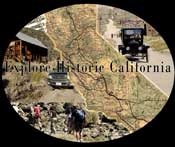|
 |
|
A photo
in the Oakland Tribune, Oct. 24, 1918,
shows Spanish influenza victims being treated in a
section of the Oakland auditorium that had been
converted into a hospital. |
The Spanish influenza pandemic of
1918-1919 was "the mother of all pandemics" according to Dr. Jeffery
K. Taubenberger and Dr. David M. Morens of the
Armed Forces
Institute of Pathology and National Institutes of Health. An
estimated 675,000 Americans and 50 million died, worldwide — more
than the total causalities of WW I.
The outbreak began
in the United States in the spring of 1918 with only a few cases
reported, "On March 30, 1918, the occurrence of eighteen cases of
influenza of severe type, from which three deaths resulted was
reported at Haskell, Kansas.” (Public Health Reports, March,
1918).
|
 |
|
The
Los Angles Times called the outbreak
"pandemic", in this headline, Sept. 14, 1918.
|
Over the following
six months the number of cases increased and the outbreak became an
"epidemic" and "pandemic" by September. The Los Angeles Times
reported on September 18, "Surgeon-General (Rupert) Blue of the
public health service has made a telegraphic survey to determine the
extent of the Spanish influenza in the United States. 'The disease
is characterized by a sudden onset,' said Dr. Blue to the Associated
Press, 'People are stricken on the streets, while at work in the
factories, shipyards, offices or elsewhere.' "
The Times
article quoted Dr. Blue as advising, "Treatment under the direction
of the physician is simple, but important, consisting principally of
rest in bed, fresh air, abundant food, with Dover's powder for the
relief of pain. Every case with fever should be regarded as serous
and kept in bed at least until temperature becomes normal."
Viruses were
unknown in 1918. Dr. Blue attributed the disease, according to the
Associated Press, as "the bacillus influenza of Pfeiffer." Methods
of control, outlined by Dr. Blue were much the same then as today,
"Isolation-bed isolation of the infected individuals during the
course of the disease; Terminal disinfection-through cleansing,
airing and sunning."
Many victims of
the outbreak were in the military. According to an Associated Press
story on September 24, 96 men had died at Camp Dix and 50 sailors, 8
marines and 83 civilians were hospitalized in New York City. "Nearly
2000 new cases of Spanish influenza in army camps had been reported
to the office of the Surgeon-General of the army today, increasing
the total number of cases to nearly 23,000."
The following day
the Times reported in an Associated Press story, "FIVE
THOUSAND GET INFLUENZA. Nearly Thirty Thousand Cases is Total
Reported. Epidemic Appears in Twenty six States. Disease Reaches
Coast in Few Isolated Cases."
"Surgeon-General
Rupert Blue of the public health service said that latest reports
showed that the malady made its appearance in twenty-six States from
the Atlantic to the Pacific. The disease is epidemic in New England,
where it first made its appearance. Influenza has appeared on the
Pacific Coast, in Washington and California, but is not yet epidemic
there."
 |
|
A
Times headline from Oct. 11, 1918 announces the
mobilization of doctors. |
But the West was
not spared. "Mobilization of all the doctors in California, Nevada
and Arizona to combat epidemics of Spanish influenza was ordered
today (October 10) by the United States public health service, it
was announced here by Dr. W. C. Billings, sanitary officer of the
service for California and Nevada. The public was warned by Dr.
Billings to avoid picture shows, churches and all other places of
assemblage until the epidemic has passed."
According to the
article, 1000 cases were reported that day in California. Los
Angeles had 86, Riverside, 160 and San Francisco, 226.
Four days later, a
Times story tried to quell residents' fears. "There is
nothing in the so-called epidemic of influenza in Los Angeles to
warrant any scare, any apprehension or any interruption of business
or the ordinary transactions of life."
Los Angeles' young
film industry was also affected by the epidemic. The Times reported,
"Triangle studio has closed for a month, and so has the Sennett
studio. No orders have yet been issued from headquarters to the Fox, Ince, Vitagraph and Metro studios. At the Lasky studio, where
several companies are working at present, Cecil de Mille and Norma
Talmadge commenced work on new pictures last week, and Vivian Martin
and Ethel Clayton are to start on new pictures today."
Impervious to the
Times' public hand holding, the number of cases continued to
increase in California. "The total number of cases of Spanish
influenza reported in California since October 1 was increased to
17,000 today (October 17) by reports of 4000 additional cases. A
proposal to close all the moving-picture theatres, churches and
other places of public assemblage in the state not subject to
medical inspection, during the Spanish influenza epidemic period, is
to be considered at a special meeting of the Board of Health here
tomorrow."
As the deadly
Spanish influenza spread, the tiny population of remote Cerro Gordo
in Inyo County was not to be spared. The disease quickly moved west
touching nearly everyone in its path by the fall of 1918.
Correspondence began pouring in and out of Cerro Gordo with
concerns, as California was hit by the deadly bug.

J. Wilson Reno was
the purchasing agent for Cerro Gordo Mines and operated out of San
Francisco.
The Mojave Desert
mining town of Randsburg did not escape the epidemic either. James
Quinn, a miner from Atolia, became ill on October 18. By order of
Judge Maginnis, he was taken to a "pesthouse" for isolation where he
died October 22. E. E. Niehaus, 26 and his wife, Edith, 21, died the
following day. The town physician, a Dr. Maxwell, was reportedly
exhausted from two weeks of overwork and was taken to Bakersfield to
recuperate. The flu outbreak was taken very seriously in the Rand
mining towns; all the bars voluntarily closed their doors.
Back in Owens
Valley, more people were falling victim to the flu.
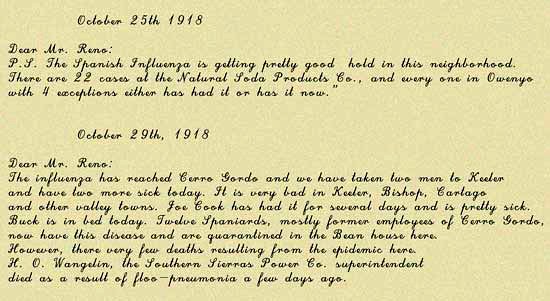

By November, the
total number of cases in California was reported to be 100,000, but
the epidemic had began to subside according to a Times story,
"The Spanish influenza epidemic has begun to subside, officials of
the State Board of Health said today. There has been a material
falling off in the number of new cases reported."
The disease did
not begin to disappear from California until the summer of 1919,
according to the U. S. Department of Health and Human Services.
Many flu remedies
and patent medicines were sold. Professor Robert C. Wilson, "head of
the department of pharmacy of one of the leading educational
institutions of the country," according to a Times story on
November 20, 1918, invented a new preventative treatment "composted
of the most powerful antiseptics and germicides known to science."
The product was called Wilson's Solution or Anti-Flu. A bottle good
for a week's treatment sold for 35 cents. Users were instructed to
sprinkle a few drops on a handkerchief and "inhale at frequent
intervals during the day, especially when entering crowds or public
places."
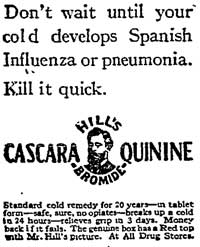 |
|
Hill's
Cascara Quinine was a frequent Times
advertiser in 1918. |
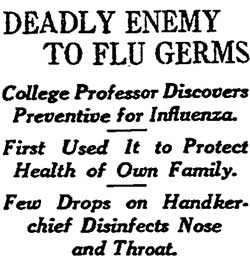 |
|
A
Times' story touts the benefits of Dr. Wilson's
treatment in Nov. 1918. |
Kerosene mixed
with sugar or turpentine with honey were a common folk remedies for
sore throat during this time period. Turpentine was also mixed with
lard and rubbed on the chest, then covered with a flannel cloth that
helped to "drive the medicine right into the lungs."
Mining camps such
as Goldfield, and Tonopah, Nevada, hit hard by the epidemic,
resorted to local remedies such as Indian root and sagebrush tree.
Tonics of hyssop, dittany, Peruvian bark, orange peel, anise,
coriander seed, gentian, yarrow, nutmeg, thyme, rose leaves and port
wine were concocted and drank by the glassful.
Whiskey was also a
popular prescription and more than likely readily available in any
isolated
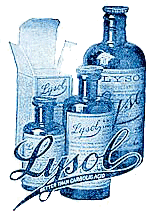 mining camp during the time period. Liquid Sozodont,
Men-Tho-Eze, Lysol disinfectant, Vicks Vapo Rub,
Hyorlick's Malted Milk, and the Hyhomel Inhaler were
also touted as good flu preventatives and germ destroyers. mining camp during the time period. Liquid Sozodont,
Men-Tho-Eze, Lysol disinfectant, Vicks Vapo Rub,
Hyorlick's Malted Milk, and the Hyhomel Inhaler were
also touted as good flu preventatives and germ destroyers.
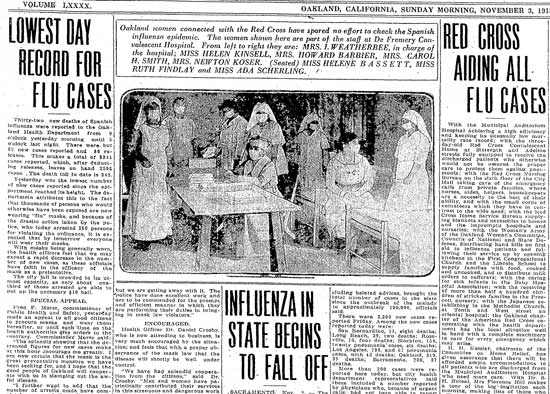 |
|
The
Oakland Tribune reported good news
about the epidemic, Nov. 3, 1918 (above). The
Times ran an ad for
Dr. Pierce's Pleasant
Purgative Pellets in January, 1919. Things were looking
better when people again had time to worry about their bowel
functions (below). |
|
 |
Bibliography
Emerging Infectious Diseases, Vol. 12, No.1, January 2006
by
Dr. Jeffery K.
Taubenberger and Dr. David M. Morens
The Reinvention of Cerro Gordo
by Cecile Page Vargo
Paper
presented at the Nevada Boom Town Conference, February 2006
The Great
Pandemic-The United States in 1918-1919
by the United States Department of Health and Human Services
http://1918.pandemicflu.gov/index.htm
http://virus.stanford.edu/uda/
Historic Los Angeles Times archive stories and advertisements
via
ProQuest
http://www.proquest.com
Historic Oakland Tribune archive stories
via
NewspaperARCHIVE.com
http://www.newspaperarchive.com/Default.aspx
|
